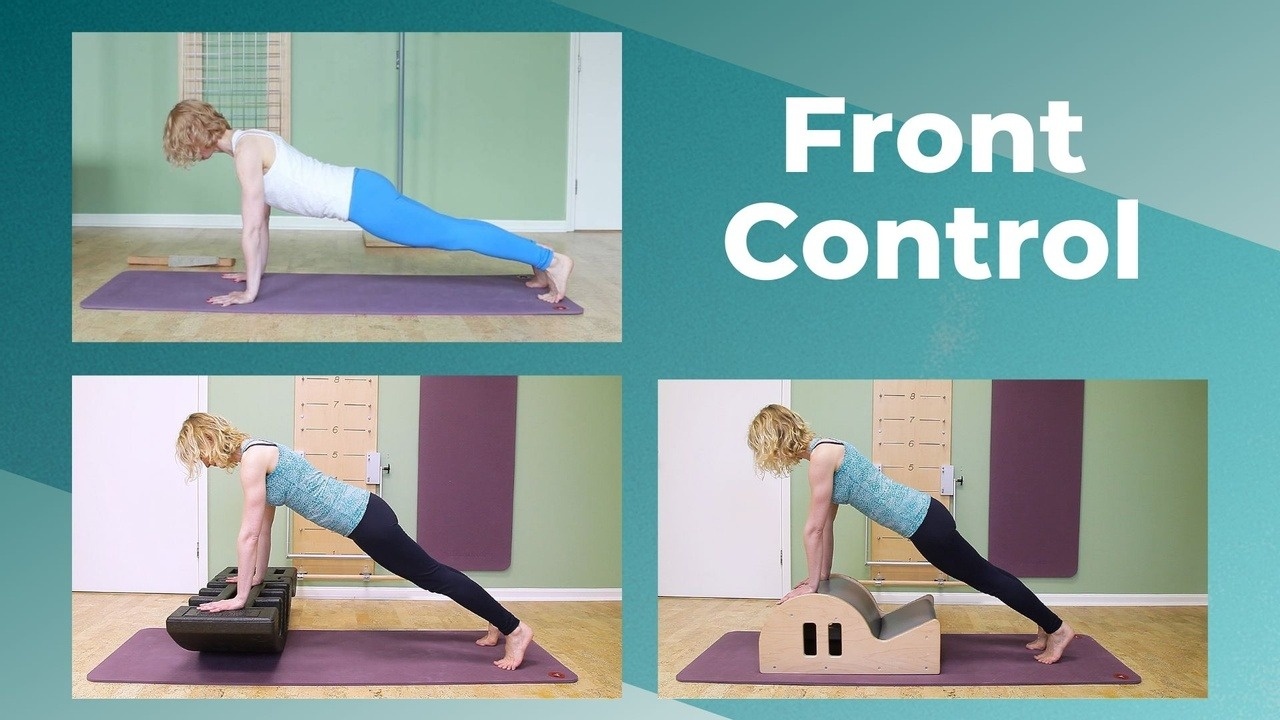Front Control (The Pilates Plank): Common Mistakes and Modifications
Jan 16, 2019
Plank! For many people, it's the epitome of core strength exercises. People hold planks for hours, literally, while others suggest there is no point in holding a plank for more than 10 seconds.
I can’t keep count of how often people mention “Plank” when suggesting exercises that improve core strength. It’s often the first exercise that comes to mind when the goal is to strengthen your abdominals and improve trunk stability.
Yes, Plank, or Front Control, as we Pilates snobs professionals like to call it, is a decent exercise with lots of benefits, but it’s not the ultimate core strength exercise. Let’s explore that.
FYI: I usually refer to a Plank as the high Push-Up position. Many people mean an Elbow Plank, where you support yourself not on your hands, but on your elbows. (Just to clear up the confusion.)
First, let's practice a Front Control so we can feel in our bodies, what's going on, and then we'll analyze. First the body, then the mind.
Since you are supporting yourself on your arms, the strength of your arms and shoulders has a lot to do with how successful you are at a Plank. If your arms, pecs, or shoulders are fairly strong, then you have a much easier time with Plank, and you might wonder what you’re doing wrong that you don’t feel your core.
Related: Tips For Correctly Stabilizing Your Spine in a Plank Position
You are also supporting yourself on your feet. If your thighs and ankles are strong, then you’ll use those more than your core.
If the opposite is true, namely that your arms and legs are on the weak side, then your core can’t get a good grip because it’s not being suspended by strong extremities.
Two very common reasons why someone might not be able to get the most out of Front Control are poor spine alignment and if the pelvis is too low.
Pilates Plank Common Mistakes
Common Plank Mistake #1: Arched Back
If someone's spine is slightly extended (arched, such as in an anterior pelvic tilt), then the abdominals are in a lengthened position which puts them at a disadvantage for contracting. If this person's abdominals are weak, then the abdominals just can't do it. By curling the tailbone slightly (image a dog with its tail between his legs), the spine is being lengthened, the abdominals shortened and the core can work the way it should.
Common Plank Mistake #2: Pelvis Too Low
We learn to align the pelvis in a diagonal from head to feet. That's a very generalized guideline and doesn't accommodate individual differences.
If your abdominals are too weak to support the weight of your pelvis suspended between shoulders and feet, then your pelvis will drop. This in turn will extend your spine and we're back and the problem above.
Imagine a heavy person lying down into a hammock, the hammock will sink lower than if a small child lies in the hammock. The hammock material in this picture is your abdominal wall. The stronger it is the more weight it can safely support. But if it's weak, it'll be sagging.
Pilates Plank Regressions
Elevate Your Torso
If a "regular" Front Control is too difficult for you or your client, make it a bit easier by elevating your upper body, such as on the Spine Corrector. (If you don't have a spine corrector, you can choose a couch or chair instead.)
If they can't support themselves on their hands, due to either weak hands or forearms or painful writs, due to carpal tunnel syndrome, for example, perform the plank on your elbows. Or choose ghosts or a wedge, depending.
Pilates Plank Progressions
To make your plank more challenging, add movement to this static hold.
Reduce the Contact Points With The Floor
Lifting one leg at a time as in the Leg Pull (that you've already seen in the video above) challenges your body to maintain its position despite the asymmetrical load. You can basically not use the strength of one leg, which means other body parts, your obliques, spine muscles, arms, and other leg have to work harder.
Place Your Hands On A Wobbly Surface
Flip your Pilates Arc upside down. Just holding the Plank position might not be such a big deal, but wait until you try to lift one leg. Whew! Now, that's a party, an #obliqueparty!
Finally, why we perceive Plank to be such a good (hear: hard) exercise is because it works on a bunch of things at the same time. It challenges three large areas of the body simultaneously, which just makes it feel harder. But it’s not the best core exercise. That award goes to Chest Lift, any exercise of the Stomach Series, the Hundred, Dead Bugs, Short Box, and a bunch more.
Related: Oblique Plank - The Best Exercise for a Tight Waist and Strong Back
Bottom line, Front Control strengthens your arms, shoulders, core, and legs. But only the front side of those areas. I highly recommend you practice Back Control (aka Upward Facing Plank) at least as often to strengthen the backside of your body. If you try it you’ll most likely discover that it’s much harder than Front Control. Because most of us are even weaker on our backsides than our fronts. Yikes.
I'd love to hear from you: Which is your favorite Pilates Plank? Shoot me an email.










